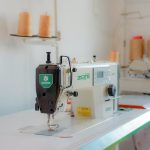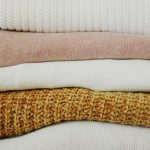Are you struggling to reinforce the seams on your delicate silk fabric? Look no further! This article will guide you through the process step by step, ensuring your seams are strong and durable.
From choosing the right thread to using different techniques like backstitching, French seams, and flat felled seams, we’ve got you covered.
Say goodbye to frayed and weak seams and hello to beautifully reinforced silk fabric!
Table of Contents
Choosing the Right Thread for Silk Fabric Seams
To reinforce your silk fabric seams, you’ll want to make sure you’re choosing the right thread.
The first thing to consider is the thread color. It’s important to choose a thread color that matches or complements the color of your silk fabric. This will ensure that the stitches blend in seamlessly and do not distract from the overall appearance of your garment.
Another crucial aspect to understand is the different thread weights. Thread weight refers to the thickness of the thread. For silk fabric, it is advisable to use a lightweight thread. A lightweight thread will be less likely to put strain on the delicate fabric and will result in a neater, more professional-looking seam.
When choosing the thread weight, it’s also important to consider the type of stitch you’ll be using. If you’re planning to sew a straight seam, a standard weight thread should suffice. However, if you’re opting for more decorative stitches or topstitching, you might want to consider using a heavier weight thread.
Preparing Silk Fabric for Seam Reinforcement
When preparing silk fabric for seam reinforcement, it is important to consider the types of reinforcement methods available to you.
There are several options to choose from, including hand stitching, machine stitching, and using fusible interfacing. Each method has its own advantages and disadvantages, so it is important to understand which one will work best for your specific project.
Additionally, having the recommended tools and materials on hand is crucial for a successful reinforcement process. Some common tools and materials include a sewing machine, hand sewing needles, thread, and fusible interfacing.
Types of Reinforcement Methods
You can reinforce silk fabric seams using various methods, such as backstitching or applying fabric tape.
When it comes to reinforcing silk fabric seams, one effective technique is using a zigzag stitch. This stitch provides added strength and flexibility to the seam, preventing it from unraveling or tearing. By sewing a zigzag stitch over the seam allowance, you create multiple layers of thread that distribute the stress evenly along the seam. This helps to prevent the fabric from fraying or coming apart.
Additionally, using hand sewing techniques for seam reinforcement has its advantages. Hand sewing allows for more precision and control, ensuring that the reinforcement is done accurately. It also gives a more finished and professional look to the seam.
Recommended Tools and Materials
Using the right tools and materials is essential for achieving strong and durable seam reinforcement.
When working with silk fabric, it’s important to choose the correct thread type for optimal results. For reinforcing silk seams, it is recommended to use silk thread or a high-quality polyester thread.
Silk thread blends seamlessly with the fabric, providing a strong bond without causing any damage. Polyester thread, on the other hand, offers excellent strength and durability, ensuring the seam remains intact over time.
In addition to the recommended thread types, there are essential sewing tools that will aid in reinforcing silk fabric seams. These include sharp fabric scissors for precise cutting, a seam ripper for removing stitches if needed, and a sewing machine with adjustable stitch length for consistent reinforcement.
Using Backstitch to Reinforce Silk Fabric Seams
If you want to reinforce the seams of your silk fabric, one of the best techniques you can use is backstitching. Backstitching provides several benefits, such as creating a strong and secure seam that can withstand regular wear and tear.
However, if you’re looking for alternatives to backstitching, you can also consider using techniques like French seams or binding the raw edges for a neat and finished look.
Benefits of Backstitching
When reinforcing silk fabric seams, it’s important to know the benefits of backstitching. Backstitching is a technique that provides strength and durability to your seams. Here are some benefits of backstitching:
- Enhanced stability: Backstitching creates a secure connection between the fabric layers, preventing them from fraying or coming apart easily.
- Added strength: By doubling back on each stitch, backstitching reinforces the seam, making it more resistant to stress and tension.
- Neat finish: Backstitching creates a clean and professional look, ensuring that your silk fabric seams stay intact and maintain their elegance.
In addition to backstitching, using a sewing machine for reinforcing silk fabric seams offers several benefits. The machine stitches are more consistent and even, providing a stronger hold. Furthermore, proper needle choice is crucial when working with delicate silk fabric. Opt for a fine needle that won’t leave visible holes or damage the fabric fibers.
Alternatives to Backstitching
For a different approach to securing your stitching, consider trying other techniques that offer similar benefits. One alternative to whipstitching is reinforcing seams with fabric glue. This method provides a strong bond that can withstand regular wear and tear. Fabric glue dries clear and flexible, ensuring that it won’t stiffen or distort the fabric. To help you decide which technique is best for your project, here is a comparison table:
| Technique | Pros |
|---|---|
| Whipstitching | Traditional and durable stitching method |
| Fabric Glue | Quick, easy, and invisible finish |
Both techniques have their advantages, so it’s important to choose the one that suits your needs and preferences. If you prefer a more traditional and durable approach, whipstitching is the way to go. On the other hand, if you value convenience and a seamless finish, fabric glue is a great alternative. Experiment with both techniques to find the one that gives you the best results.
Reinforcing Silk Fabric Seams With French Seams
To reinforce silk fabric seams, you can use French seams. French seams are a popular technique for reinforcing delicate fabrics like silk. They provide a clean and finished look to the seams while preventing fraying and adding strength. Here are some key points to keep in mind when using French seams for silk fabric:
-
Accuracy: Accuracy is crucial when working with silk fabric and French seams. Take your time to measure and mark your seam allowances accurately before sewing.
-
Narrow seam allowances: Use narrow seam allowances, typically 1/4 inch or less, to reduce bulk and ensure a neat finish.
-
Pressing: Press your seams carefully at each step to create crisp and flat seams. Use a pressing cloth to protect the delicate silk fabric from heat damage.
Common mistakes in silk fabric seam reinforcement include:
-
Using large seam allowances: Using large seam allowances can create unnecessary bulk and make the finished seam appear bulky and unattractive.
-
Skipping pressing: Skipping pressing at each step can result in uneven and puckered seams. Take the time to press your seams to ensure a professional finish.
-
Not using a fine needle: Using a fine needle is essential when working with silk fabric. A fine needle will minimize the risk of snagging or damaging the delicate fabric.
Using Seam Binding to Reinforce Silk Fabric Seams
Using seam binding is a great method for adding extra strength and durability to silk fabric. Seam binding is a narrow strip of fabric that is used to encase the raw edges of a seam, preventing fraying and providing reinforcement. It is a versatile alternative to other seam binding alternatives, such as bias tape or ribbon, as it can be made from the same fabric as the garment, ensuring a seamless and cohesive look.
To use seam binding, start by cutting a strip of fabric that is about 1 inch wide and the same length as the seam you want to reinforce. Fold the strip in half lengthwise, wrong sides together, and press it to create a crease. Open the strip and align the raw edge of the fabric with the raw edge of the seam. Fold the strip over the raw edge, encasing it completely, and pin it in place.
Now, using a straight stitch or a narrow zigzag stitch, sew along the edge of the seam binding, securing it to the fabric. Be sure to catch both layers of the seam binding and the fabric in your stitching.
For added strength, you can also hand stitch the seam binding using techniques such as slip stitch or catch stitch. These hand stitching techniques will provide extra reinforcement and durability to your silk fabric seams.
Reinforcing Silk Fabric Seams With Flat Felled Seams
When reinforcing silk fabric seams, one effective technique is to use flat felled seams. This method not only strengthens the seams but also provides a clean and professional finish.
Here are some tips to help you reinforce silk fabric seams using flat felled seams:
-
Using a serger: A serger is a great tool for finishing raw edges of silk fabric seams. It trims the excess fabric and stitches over the edge, preventing fraying and adding durability to the seam. Simply run the fabric through the serger, aligning the edges, and let the machine do the work.
-
Hand sewing techniques: If you prefer a more traditional approach, hand sewing techniques can also be used to reinforce silk fabric seams. One method is to sew a row of small backstitches along the seam allowance, about 1/4 inch from the edge. This will secure the fabric and prevent fraying.
-
Flat felled seams: To create a flat felled seam, start by sewing the fabric with a regular seam allowance. Then, trim one side of the seam allowance close to the stitching line. Fold the remaining seam allowance over the trimmed edge and press it flat. Finally, stitch close to the folded edge to secure the seam. This technique not only reinforces the seam but also gives it a neat and polished look.
Applying Fusible Interfacing for Seam Reinforcement on Silk Fabric
For a more secure and professional finish, consider applying fusible interfacing to strengthen your silk fabric. Choosing the right interfacing for silk fabric seams is crucial to ensure that your seams remain strong and durable. When selecting interfacing, opt for a lightweight and thin option that won’t add bulk to your fabric. Look for a fusible interfacing specifically designed for delicate fabrics like silk.
To apply fusible interfacing to your silk fabric, start by cutting a piece of interfacing that matches the shape and size of your seam allowance. Place the interfacing on the wrong side of the fabric, with the adhesive side facing down. Use a pressing cloth to protect your silk fabric and iron the interfacing in place, following the instructions provided by the manufacturer. Be sure to use a low heat setting and avoid applying too much pressure as it can damage the delicate silk fibers.
If you prefer hand sewing your silk fabric seams, there are techniques you can use to reinforce them. Begin by choosing a fine silk thread that matches your fabric color. When sewing the seams, use small, neat stitches to secure the fabric layers together. Take care to avoid pulling the stitches too tightly, as it can cause the fabric to pucker or distort. Additionally, consider using a backstitch or a catch stitch for added strength and stability.
Conclusion
So there you have it, a complete guide on how to reinforce silk fabric seams.
By choosing the right thread and preparing the fabric properly, you can ensure that your seams will be strong and durable.
Whether you use backstitch, French seams, seam binding, flat felled seams, or fusible interfacing, each method has its own benefits and can be used depending on your specific needs.
So go ahead and give these techniques a try, and enjoy sewing with silk fabrics with confidence!
- How Does Ring Spun Cotton Affect Garment Fit and Shape Retention? - August 13, 2024
- What Are the Challenges in Producing Ring Spun Cotton? - August 13, 2024
- Is Ring Spun Cotton Suitable for Plus-Size Clothing? - August 13, 2024






